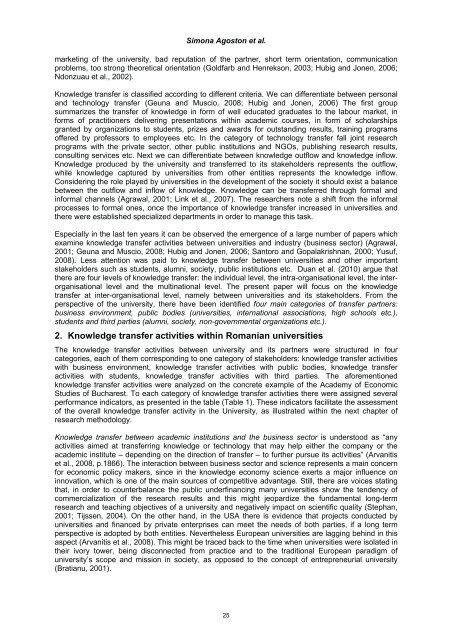Proceedings of the 3rd European Conference on Intellectual Capital
Proceedings of the 3rd European Conference on Intellectual Capital
Proceedings of the 3rd European Conference on Intellectual Capital
Create successful ePaper yourself
Turn your PDF publications into a flip-book with our unique Google optimized e-Paper software.
Sim<strong>on</strong>a Agost<strong>on</strong> et al.<br />
marketing <str<strong>on</strong>g>of</str<strong>on</strong>g> <str<strong>on</strong>g>the</str<strong>on</strong>g> university, bad reputati<strong>on</strong> <str<strong>on</strong>g>of</str<strong>on</strong>g> <str<strong>on</strong>g>the</str<strong>on</strong>g> partner, short term orientati<strong>on</strong>, communicati<strong>on</strong><br />
problems, too str<strong>on</strong>g <str<strong>on</strong>g>the</str<strong>on</strong>g>oretical orientati<strong>on</strong> (Goldfarb and Henreks<strong>on</strong>, 2003; Hubig and J<strong>on</strong>en, 2006;<br />
Nd<strong>on</strong>zuau et al., 2002).<br />
Knowledge transfer is classified according to different criteria. We can differentiate between pers<strong>on</strong>al<br />
and technology transfer (Geuna and Muscio, 2008; Hubig and J<strong>on</strong>en, 2006) The first group<br />
summarizes <str<strong>on</strong>g>the</str<strong>on</strong>g> transfer <str<strong>on</strong>g>of</str<strong>on</strong>g> knowledge in form <str<strong>on</strong>g>of</str<strong>on</strong>g> well educated graduates to <str<strong>on</strong>g>the</str<strong>on</strong>g> labour market, in<br />
forms <str<strong>on</strong>g>of</str<strong>on</strong>g> practiti<strong>on</strong>ers delivering presentati<strong>on</strong>s within academic courses, in form <str<strong>on</strong>g>of</str<strong>on</strong>g> scholarships<br />
granted by organizati<strong>on</strong>s to students, prizes and awards for outstanding results, training programs<br />
<str<strong>on</strong>g>of</str<strong>on</strong>g>fered by pr<str<strong>on</strong>g>of</str<strong>on</strong>g>essors to employees etc. In <str<strong>on</strong>g>the</str<strong>on</strong>g> category <str<strong>on</strong>g>of</str<strong>on</strong>g> technology transfer fall joint research<br />
programs with <str<strong>on</strong>g>the</str<strong>on</strong>g> private sector, o<str<strong>on</strong>g>the</str<strong>on</strong>g>r public instituti<strong>on</strong>s and NGOs, publishing research results,<br />
c<strong>on</strong>sulting services etc. Next we can differentiate between knowledge outflow and knowledge inflow.<br />
Knowledge produced by <str<strong>on</strong>g>the</str<strong>on</strong>g> university and transferred to its stakeholders represents <str<strong>on</strong>g>the</str<strong>on</strong>g> outflow,<br />
while knowledge captured by universities from o<str<strong>on</strong>g>the</str<strong>on</strong>g>r entities represents <str<strong>on</strong>g>the</str<strong>on</strong>g> knowledge inflow.<br />
C<strong>on</strong>sidering <str<strong>on</strong>g>the</str<strong>on</strong>g> role played by universities in <str<strong>on</strong>g>the</str<strong>on</strong>g> development <str<strong>on</strong>g>of</str<strong>on</strong>g> <str<strong>on</strong>g>the</str<strong>on</strong>g> society it should exist a balance<br />
between <str<strong>on</strong>g>the</str<strong>on</strong>g> outflow and inflow <str<strong>on</strong>g>of</str<strong>on</strong>g> knowledge. Knowledge can be transferred through formal and<br />
informal channels (Agrawal, 2001; Link et al., 2007). The researchers note a shift from <str<strong>on</strong>g>the</str<strong>on</strong>g> informal<br />
processes to formal <strong>on</strong>es, <strong>on</strong>ce <str<strong>on</strong>g>the</str<strong>on</strong>g> importance <str<strong>on</strong>g>of</str<strong>on</strong>g> knowledge transfer increased in universities and<br />
<str<strong>on</strong>g>the</str<strong>on</strong>g>re were established specialized departments in order to manage this task.<br />
Especially in <str<strong>on</strong>g>the</str<strong>on</strong>g> last ten years it can be observed <str<strong>on</strong>g>the</str<strong>on</strong>g> emergence <str<strong>on</strong>g>of</str<strong>on</strong>g> a large number <str<strong>on</strong>g>of</str<strong>on</strong>g> papers which<br />
examine knowledge transfer activities between universities and industry (business sector) (Agrawal,<br />
2001; Geuna and Muscio, 2008; Hubig and J<strong>on</strong>en, 2006; Santoro and Gopalakrishnan, 2000; Yusuf,<br />
2008). Less attenti<strong>on</strong> was paid to knowledge transfer between universities and o<str<strong>on</strong>g>the</str<strong>on</strong>g>r important<br />
stakeholders such as students, alumni, society, public instituti<strong>on</strong>s etc. Duan et al. (2010) argue that<br />
<str<strong>on</strong>g>the</str<strong>on</strong>g>re are four levels <str<strong>on</strong>g>of</str<strong>on</strong>g> knowledge transfer: <str<strong>on</strong>g>the</str<strong>on</strong>g> individual level, <str<strong>on</strong>g>the</str<strong>on</strong>g> intra-organisati<strong>on</strong>al level, <str<strong>on</strong>g>the</str<strong>on</strong>g> interorganisati<strong>on</strong>al<br />
level and <str<strong>on</strong>g>the</str<strong>on</strong>g> multinati<strong>on</strong>al level. The present paper will focus <strong>on</strong> <str<strong>on</strong>g>the</str<strong>on</strong>g> knowledge<br />
transfer at inter-organisati<strong>on</strong>al level, namely between universities and its stakeholders. From <str<strong>on</strong>g>the</str<strong>on</strong>g><br />
perspective <str<strong>on</strong>g>of</str<strong>on</strong>g> <str<strong>on</strong>g>the</str<strong>on</strong>g> university, <str<strong>on</strong>g>the</str<strong>on</strong>g>re have been identified four main categories <str<strong>on</strong>g>of</str<strong>on</strong>g> transfer partners:<br />
business envir<strong>on</strong>ment, public bodies (universities, internati<strong>on</strong>al associati<strong>on</strong>s, high schools etc.),<br />
students and third parties (alumni, society, n<strong>on</strong>-governmental organizati<strong>on</strong>s etc.).<br />
2. Knowledge transfer activities within Romanian universities<br />
The knowledge transfer activities between university and its partners were structured in four<br />
categories, each <str<strong>on</strong>g>of</str<strong>on</strong>g> <str<strong>on</strong>g>the</str<strong>on</strong>g>m corresp<strong>on</strong>ding to <strong>on</strong>e category <str<strong>on</strong>g>of</str<strong>on</strong>g> stakeholders: knowledge transfer activities<br />
with business envir<strong>on</strong>ment, knowledge transfer activities with public bodies, knowledge transfer<br />
activities with students, knowledge transfer activities with third parties. The aforementi<strong>on</strong>ed<br />
knowledge transfer activities were analyzed <strong>on</strong> <str<strong>on</strong>g>the</str<strong>on</strong>g> c<strong>on</strong>crete example <str<strong>on</strong>g>of</str<strong>on</strong>g> <str<strong>on</strong>g>the</str<strong>on</strong>g> Academy <str<strong>on</strong>g>of</str<strong>on</strong>g> Ec<strong>on</strong>omic<br />
Studies <str<strong>on</strong>g>of</str<strong>on</strong>g> Bucharest. To each category <str<strong>on</strong>g>of</str<strong>on</strong>g> knowledge transfer activities <str<strong>on</strong>g>the</str<strong>on</strong>g>re were assigned several<br />
performance indicators, as presented in <str<strong>on</strong>g>the</str<strong>on</strong>g> table (Table 1). These indicators facilitate <str<strong>on</strong>g>the</str<strong>on</strong>g> assessment<br />
<str<strong>on</strong>g>of</str<strong>on</strong>g> <str<strong>on</strong>g>the</str<strong>on</strong>g> overall knowledge transfer activity in <str<strong>on</strong>g>the</str<strong>on</strong>g> University, as illustrated within <str<strong>on</strong>g>the</str<strong>on</strong>g> next chapter <str<strong>on</strong>g>of</str<strong>on</strong>g><br />
research methodology.<br />
Knowledge transfer between academic instituti<strong>on</strong>s and <str<strong>on</strong>g>the</str<strong>on</strong>g> business sector is understood as “any<br />
activities aimed at transferring knowledge or technology that may help ei<str<strong>on</strong>g>the</str<strong>on</strong>g>r <str<strong>on</strong>g>the</str<strong>on</strong>g> company or <str<strong>on</strong>g>the</str<strong>on</strong>g><br />
academic institute – depending <strong>on</strong> <str<strong>on</strong>g>the</str<strong>on</strong>g> directi<strong>on</strong> <str<strong>on</strong>g>of</str<strong>on</strong>g> transfer – to fur<str<strong>on</strong>g>the</str<strong>on</strong>g>r pursue its activities” (Arvanitis<br />
et al., 2008, p.1866). The interacti<strong>on</strong> between business sector and science represents a main c<strong>on</strong>cern<br />
for ec<strong>on</strong>omic policy makers, since in <str<strong>on</strong>g>the</str<strong>on</strong>g> knowledge ec<strong>on</strong>omy science exerts a major influence <strong>on</strong><br />
innovati<strong>on</strong>, which is <strong>on</strong>e <str<strong>on</strong>g>of</str<strong>on</strong>g> <str<strong>on</strong>g>the</str<strong>on</strong>g> main sources <str<strong>on</strong>g>of</str<strong>on</strong>g> competitive advantage. Still, <str<strong>on</strong>g>the</str<strong>on</strong>g>re are voices stating<br />
that, in order to counterbalance <str<strong>on</strong>g>the</str<strong>on</strong>g> public underfinancing many universities show <str<strong>on</strong>g>the</str<strong>on</strong>g> tendency <str<strong>on</strong>g>of</str<strong>on</strong>g><br />
commercializati<strong>on</strong> <str<strong>on</strong>g>of</str<strong>on</strong>g> <str<strong>on</strong>g>the</str<strong>on</strong>g> research results and this might jeopardize <str<strong>on</strong>g>the</str<strong>on</strong>g> fundamental l<strong>on</strong>g-term<br />
research and teaching objectives <str<strong>on</strong>g>of</str<strong>on</strong>g> a university and negatively impact <strong>on</strong> scientific quality (Stephan,<br />
2001; Tijssen, 2004). On <str<strong>on</strong>g>the</str<strong>on</strong>g> o<str<strong>on</strong>g>the</str<strong>on</strong>g>r hand, in <str<strong>on</strong>g>the</str<strong>on</strong>g> USA <str<strong>on</strong>g>the</str<strong>on</strong>g>re is evidence that projects c<strong>on</strong>ducted by<br />
universities and financed by private enterprises can meet <str<strong>on</strong>g>the</str<strong>on</strong>g> needs <str<strong>on</strong>g>of</str<strong>on</strong>g> both parties, if a l<strong>on</strong>g term<br />
perspective is adopted by both entities. Never<str<strong>on</strong>g>the</str<strong>on</strong>g>less <str<strong>on</strong>g>European</str<strong>on</strong>g> universities are lagging behind in this<br />
aspect (Arvanitis et al., 2008). This might be traced back to <str<strong>on</strong>g>the</str<strong>on</strong>g> time when universities were isolated in<br />
<str<strong>on</strong>g>the</str<strong>on</strong>g>ir ivory tower, being disc<strong>on</strong>nected from practice and to <str<strong>on</strong>g>the</str<strong>on</strong>g> traditi<strong>on</strong>al <str<strong>on</strong>g>European</str<strong>on</strong>g> paradigm <str<strong>on</strong>g>of</str<strong>on</strong>g><br />
university’s scope and missi<strong>on</strong> in society, as opposed to <str<strong>on</strong>g>the</str<strong>on</strong>g> c<strong>on</strong>cept <str<strong>on</strong>g>of</str<strong>on</strong>g> entrepreneurial university<br />
(Bratianu, 2001).<br />
25
















